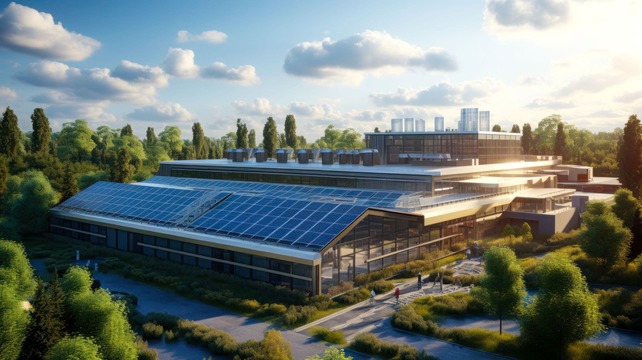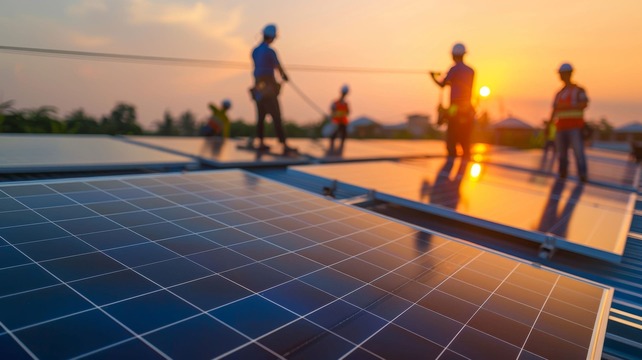In recent years, the adoption of renewable energy sources has significantly increased across various sectors. For instance, commercial enterprises have grown interested in solar energy as a sustainable and cost-effective alternative. This interest is driven by both environmental concerns and the potential for long-term savings on energy costs.
Understanding the financial implications of installing commercial solar panels is also crucial for businesses considering this investment. But how much do commercial solar panels cost?
Read on to learn more.
Long-Term Benefits For Businesses
Adopting solar technology offers numerous long-term benefits for businesses beyond immediate financial savings. First, it can significantly reduce a company’s carbon footprint, an increasingly important factor for businesses committed to sustainability. This can enhance a company’s public image and appeal to a growing demographic of environmentally conscious consumers.
Moreover, solar energy contributes to energy independence, reducing reliance on local utility providers and protecting against fluctuating energy prices. Another strategic advantage is the potential increase in property values, as buildings with solar installations often attract more interest and command higher prices.
Lastly, business owners interested in leveraging these benefits can learn the benefits of solar panels for businesses to better understand how solar energy can positively impact their operations and public perception.
Initial Investment In Commercial Solar Panels
The upfront cost of commercial solar panels is one of the most significant factors for any business to consider. These costs are primarily influenced by the size of the system required, the quality of the panels, and the complexity of the installation. For a standard commercial installation, expenses can range from approximately USD$50,000 to over USD$1 million, depending on the system’s capacity.
Furthermore, these initial costs include the solar panels themselves, inverters, mounting systems, wiring, and labor. While more expensive, high-efficiency panels can generate more electricity and thus offer greater long-term savings. Lastly, businesses must account for potential structural reinforcements to their premises, which can add to the initial investment.
Ongoing Costs And Maintenance
After installing commercial solar panels, ongoing expenses are much lower than those associated with conventional power sources. The primary ongoing costs include regular system performance monitoring and periodic maintenance such as cleaning and inspections to ensure everything operates efficiently. Typically, the largest expense might be the replacement of inverters, which are essential for converting solar energy into usable electricity and tend to have a lifespan of 10 to 15 years.
Additionally, while solar panels have a long lifespan of up to 30 years, their efficiency can degrade slightly over time—usually by about 0.5% to 1% per year. Even with these reductions in efficiency, the overall maintenance and operational costs of solar panels are minimal compared to the rising costs of non-renewable energy sources, securing solar energy as a cost-effective solution for the long term.

Tax Incentives And Rebates
Governments at various levels offer a range of incentives to promote the adoption of solar energy by businesses. These financial incentives include tax credits, rebates, and grants, which can significantly lower the initial and ongoing costs of a solar setup. For example, the federal solar investment tax credit (ITC) is particularly notable, allowing businesses to deduct 26% of the cost of installing a solar energy system from their federal taxes.
Furthermore, many states and localities offer incentives, such as additional tax rebates or grants, to reduce costs further. These incentives can vary widely by location and are subject to change, so businesses must stay informed of the latest opportunities. By taking advantage of these financial incentives, enterprises can dramatically decrease the net cost of their solar energy systems, making solar investments even more financially appealing.
Financing Options For Solar Energy
The high initial solar panel installation costs can be a barrier for many businesses. To address this, the market offers various financing models that make solar energy accessible without substantial upfront investment. Loans are a straightforward option, providing enterprises with the capital to purchase and own the system, typically benefiting from tax credits and depreciation. Leasing is another popular choice, where businesses pay a monthly fee to use the solar system without owning it, which often includes maintenance and repairs.
Additionally, power purchase agreements (PPAs) are advantageous for companies that wish to avoid initial expenses and maintenance responsibilities. Under a PPA, a third party owns the solar system, and the business only pays for the electricity produced, often at rates lower than utility prices, providing immediate savings with no capital investment.
Calculating The Break-Even Point
Determining when a solar investment will start to pay off, or reach its break-even point, is crucial for business planning. This point is influenced by several factors including the upfront cost, financing terms, and ongoing electricity costs from the grid. Furthermore, geographical location plays a significant role, as it affects how much sunlight the panels will receive and how much electricity they’ll generate. Most commercial solar installations are designed to break even within 5 to 10 years.
After reaching the break-even point, the system will continue to produce energy, resulting in substantial cost savings over time. By understanding these dynamics, businesses can make informed decisions about solar investments and manage expectations regarding financial returns.
Future Trends In Solar Energy Costs
The cost of solar technology has consistently fallen over the past decade due to technological advancements and increased production scales, making it more competitive against traditional energy sources. This trend is expected to persist as innovations continue to improve efficiency and lower costs.
Also, evolving regulatory environments are likely to introduce new incentives aimed at promoting renewable energy adoption, potentially reducing costs further. As solar technology becomes more mainstream, its integration into the commercial sector is expected to increase, driving demand and competition in the market. This shift promises to make solar energy more accessible to a broader range of businesses and contributes to the global transition towards more sustainable energy solutions.
Final Thoughts
Investing in commercial solar panels involves considerable upfront costs, but the long-term savings, combined with the environmental benefits, make it a worthwhile investment for many businesses. By understanding all associated costs, incentives, and financing options, companies can make informed decisions that align with their financial and environmental goals.
As solar technology costs continue to decrease, more businesses are likely to adopt this sustainable energy solution, contributing to a greener and more energy-efficient future.





